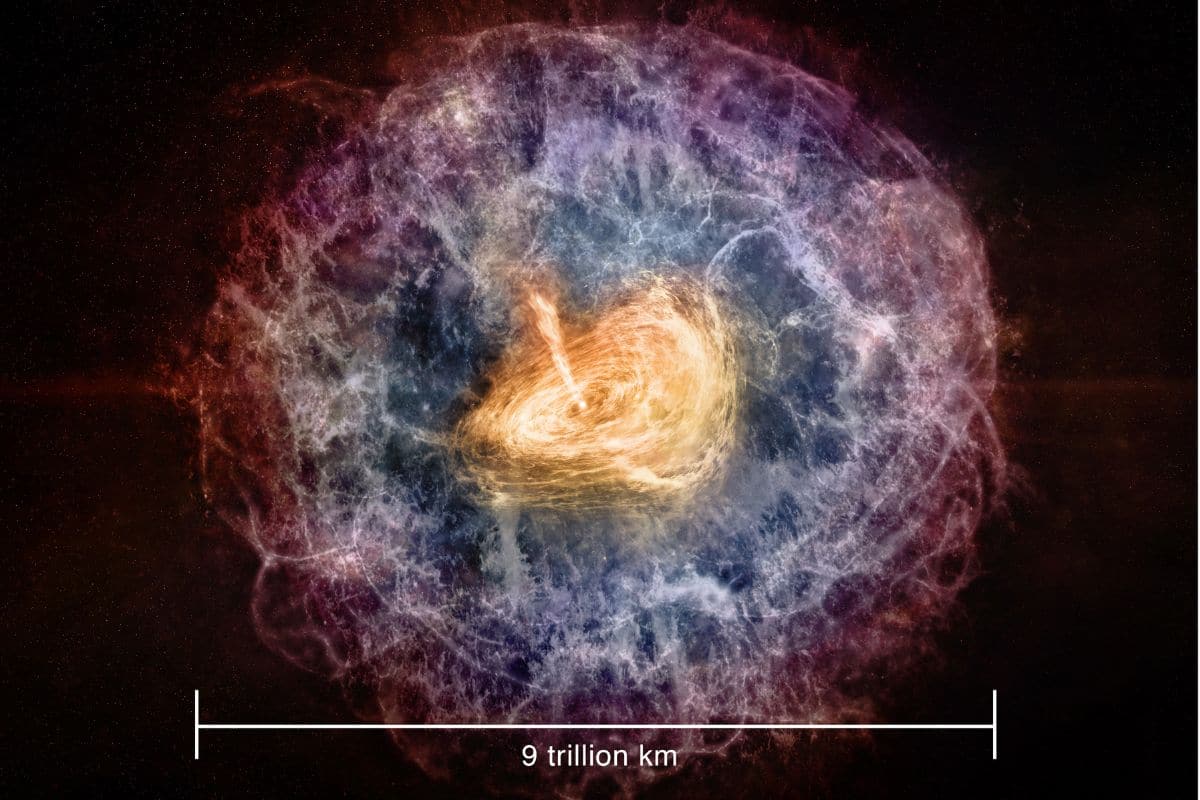

The object—which may well be the successor to the famous Crab Nebula—may be only fourteen years old.
A neutron star is the remnant of a massive star that exploded as a supernova. Although we know of the existence of quite a few neutron stars at this point, researchers have now stumbled upon a very remarkable one. Because in a new study they claim to have discovered a very young neutron star that is really only just arriving.
VT 1137-0337
Named VT 1137-0337, the object is located in a dwarf galaxy about 395 million light-years from Earth. Researchers discovered the object after analyzing data from the VLA Sky Survey (VLASS), which studies about 80 percent of the sky. Over a period of seven years, VLASS has already completed three full scans of the sky, revealing 20 unusual objects. The astronomers found VT 1137-0337 in the first VLASS scan from 2018. “VT 1137-0337 stood out because of the massive star formation taking place in its galaxy,” said researcher Dillon Dong. “We also discovered special features of radio emission.”
peep boy
The researchers believe that VT 1137-0337 is a pulsar — a rapidly spinning neutron star — that is still very young. “Based on its characteristics, this is a very young pulsar — possibly as young as 14 years old,” said researcher Gregg Hallinan. “He’s not older than 60 or 80 anyway.” And that is exceptional. Rarely are such young specimens discovered. The researchers therefore suspect that this is one of the youngest neutron stars ever found.
Pulsar wind nebula
But that’s not all. The researchers think that VT 1137-0337 may represent a peculiar phenomenon. “What we’re probably seeing is a pulsar wind nebula,” Dong says. A pulsar wind nebula forms when the powerful magnetic field of a rapidly spinning neutron star accelerates surrounding charged particles to nearly the speed of light.
Perhaps the most famous example of a pulsar wind nebula is the Crab Nebula in the constellation Taurus. The Crab Nebula is the result of a supernova explosion that appeared in the night sky in 1054. The explosion was so bright that the remnant of the star was visible to the naked eye for 23 days at noon. Over the years, decades, and centuries that followed, the mist slowly faded. Today, the Crab Nebula can only be observed with good binoculars or a small amateur telescope. “The object we discovered appears to be about 10,000 times more energetic than the Crab, with a stronger magnetic field,” Dong said. “It’s probably an upcoming ‘Super Crab’”.

Top left: A giant star, much more massive than our sun, has reached the end of its life. Because this star is so massive, its outer shell explodes as a result of an implosion of the star’s interior. When a massive star collapses, a supernova explosion occurs.
Top right: The collapse has begun, creating a super-dense neutron star with a strong magnetic field. Although the neutron star is about 1.5 solar masses, it is only as big as Manhattan.
Bottom left: The supernova explosion has thrown a fast-moving shell of debris. At this stage, the curtain is close enough to obscure radio waves coming from the region of the neutron star.
Bottom right: The curtain of explosive debris became thinner and thinner over time. Eventually it even became so thin that radio waves found their way through. Because of this, observations using VLASS led to the discovery of bright radio emission. Image: Melissa Weiss, NRAO/AUI/NSF
It’s no surprise that the radio emission from VT 1137-0337 was only discovered in 2018 and was not seen in previous images of the same region. Initially, the radio emission was hidden from view by a thick curtain consisting of explosion residues, the researchers explain. As that curtain expanded, it became thinner and thinner, until eventually the radio waves from the pulsar wind nebula found their way through. In short, VT 1137-0337 probably only recently emerged from behind a thick curtain of rubble.
Alternative theory
While Dong and Hallinan think VT 1137-0337 is most likely a pulsar wind nebula, they also have an alternative theory. Because given the strong magnetic field of the neutron star, it could also just be a magnetar: young and very rare neutron stars, with an exceptionally strong magnetic field. Magnetars are thought to be able to emit fast radio bursts; phenomena that are intensively studied. “If this alternative theory is correct, this would be the first magnetar to be caught appearing,” Dong says. “And that, too, would be extremely exciting.”
The astronomers plan to conduct further observations. In this way, they hope to learn more about the object and closely monitor its behavior over time. And then hopefully it will show how the fork really is in the stem.
Source material:
†Astronomers find evidence for most powerful pulsar in distant galaxy– National Radio Astronomy Observatory (via EurekAlert)
Image at the top of this article: Melissa Weiss, NRAO/AUI/NSF